 Leading Blog | Posts by Month |
 Leading Blog | Posts by Month |
08.31.09

LeadershipNow 140: August 2009 Compilation
Posted by Michael McKinney at 12:01 AM
08.28.09

IBM's Robert Sampson on Values-Based LeadershipRobert Sampson, general manager of Global Public Sector at IBM, delivered a speech to the Industrial College of the Armed Forces, on the power of values to change the world. He says, “Technologies, no matter how game-changing they are, come and go. What really matters in industry and in government is individual character.”Sampson relates the story of an IBM computer scientist named Arun Hampapur who was driven to enhance the value derived from surveillance systems, to illustrate the value of creating a culture in which people seek to innovate not just for the sake of innovation, but to apply themselves to the kind of innovation that changes society: Arun Hampapur began studying the video surveillance systems in New York and Chicago. As Arun saw it, these systems had an inherent problem: They could ingest data, but they could not react to real-world incidents in a timely way. You could only respond to a criminal event once it already happened. That wasn’t good enough for Arun.
Posted by Michael McKinney at 01:16 AM
08.26.09

Do You Have a System for Thinking?Gerald Sindell has developed a system for thinking through and developing ideas called The Genius Machine. The eleven step system is designed to develop and polish an existing idea, think through a complete issue, or create something entirely new—to create something with a goal in mind. “It’s fast, it’s complete, it helps people get to the bottom of what they need to think through, and it anticipates the outreach part of innovation at the very beginning.”Ideas enter the process fuzzy, weak, and partially baked. Using the eleven steps– Distinction (seeing something new), Identity (knowing who you are and why you are driven to share your idea), Implications (exploring every possible consequence of your idea), Testing (find the breaking point), Precedent (who else has done something like this), Need (who will it be most valuable for / focus on your audience), Foundation (discover the underlying principles or rules), Completion (can your idea stand on its own), Connecting (flattening the learning curve), Impact (is the impact of your idea in alignment with your goals) and Advocacy (you must champion your ideas) –those ideas are examined from every angle and leave robust, polished, bulletproof, and ready to change the world. Sindell says that after you use The Genius Machine for awhile it will turn you into a noticer. You’ll start to realize that you see things no one else does. And those are the very things that are important to you. You might notice really subtle things, like how the wind blows a leaf, or you might notice the various ways an airplane flying overhead sounds to you depending on the cloud cover, or you might notice how your sister kind of rolls her eyes when she has something important she’s about to say.The Genius Machine is a repeatable process that encourages the deeper exploration of complex problems for better solutions. When used properly, it becomes a thorough organized system of thinking to develop any intellectual property.
Posted by Michael McKinney at 08:16 AM
08.25.09

Leading Views: Manager as Orchestra Conductor In Managerial Behavior: Administration in Complex Organizations, Leonard Sayles creates a more realistic picture of the manager/leader as orchestra conductor: In Managerial Behavior: Administration in Complex Organizations, Leonard Sayles creates a more realistic picture of the manager/leader as orchestra conductor:
"The manager is like a symphony orchestra conductor, endeavoring to maintain a melodious performance in which the contributions of the various instruments are coordinated and sequenced, patterned and paced, while the orchestra members are having various personal difficulties, stage hands are moving music stands, alternating excessive heat and cold are creating audience and instrumental problems, and the sponsor of the concert is insisting on irrational changes in the program."
Posted by Michael McKinney at 09:47 AM
08.24.09

A Leader Builds CommunityIt’s easy to lead the people who think you can do no wrong. It’s easy too, to get taken in by their flattery. But a leader is responsible for everyone they lead – their core supporters and those at the fringe that may have their doubts. A leader builds community. A leader is inclusive.In Driving Results Through Social Networks, Cross and Thomas report that “high performers tend to occupy network positions that bridge otherwise disconnected clusters of people.” As a result they can seize the opportunities found in the “white space” between subgroups. A diversity of voices is essential to a leader. It is not uncommon to find that your most crucial collaborators are not commonly categorized as the high performers and regarded as "in-sync" with you. Instead, we have all seen that these highly valuable people, often found on the fringes, play an important role in making the high performers successful. A leader must be able to motivate these potential partners to join with them as well. Jagdish Sheth, a chaired professor of marketing at Emory’s Goizueta Business School notes, “One big mistake is when the new leader rewards the people who supported him on the way up, while phasing out the people who did not. Instead, a CEO must realize that he or she is the leader of the company, not a clique, just as the president of the U.S. leads the nation, not just the Democrats or the Republicans.” Where there is leadership, there is a sense of community.
Posted by Michael McKinney at 08:00 AM
08.21.09

12 Keys to Greater Self-Awareness
THERE IS NO evidence to suggest that any species of animals other than humans come pre-packaged with a set of mechanisms for any kind of meaningful self-awareness—to ask what and why. The degree to which we develop and use that capacity, in a constructive way, will largely determine our success in life. 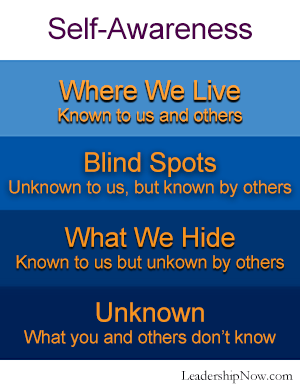 Self-awareness is where leadership development begins. Self-management and authenticity flow from self-awareness. Self-awareness can be divided into four parts: what is known to us and others, what is known to others but not by us, what we know and others don’t and what we don’t know and others don’t either. Plumbing the depths of self-awareness takes time and more intensive tactics. However, our biggest gain in self-improvement can be had by finding out what others know that we don’t. And they know more than we think. Here are twelve keys to greater self-awareness:
Your thinking and the behavior that flows from that has brought you to where you are now. You are in control of developing the thinking and behavior that will take you where you want to go. Self–awareness is difficult. We don’t always like to admit things about ourselves because we don’t like the guilt associated with not doing what we know we should. But admit we must if we are to grow. Ask yourself, “In light of where I come from, what do I need to know about myself?” Warren Bennis wrote, “It is one of the paradoxes of life that good leaders rise to the top in spite of their weaknesses, while bad leaders rise because of their weakness….We are our own raw material. Only when we know what we are made of and what we want to make of it can we begin our lives—and we must do it despite an unwitting conspiracy of people and events against us.” It is a lifelong and rewarding journey.
Posted by Michael McKinney at 12:09 AM
08.20.09

What Is Meaningful Today Will Remain Meaningful Tomorrow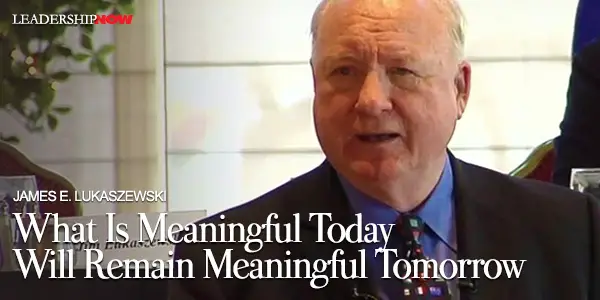
 CEO of The Lukaszewski Group Inc., James E. Lukaszewski (loo-ka-SHEV-skee) has been named as one of the top “28 experts to call when all hell breaks loose.” He is a coach to many CEOs and author of the excellent book, Why Should the Boss Listen to You? He also maintains the Crisis Guru Blog. In a presentation earlier this year, he offered this advice: When you get to be my age and look like me, you tend to get a lot of trend type questions. It’s a polite way of being asked to share the observations of a long and, presumably, useful career. In my case, the question, specifically, is often about trends in crisis situations, since that’s been the main focus of my career and work. “Was I seeing new or different kinds of crimes or problems committed by clients?” I usually respond with a question—have there been any new Commandments since the last 10 came out? The questioner, usually with a puzzled face, will say, “Well, no. The 10 we have are the 10 we’ve got.” 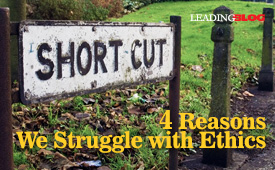 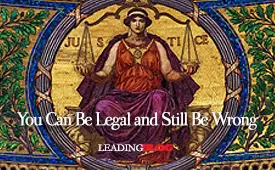
Posted by Michael McKinney at 07:46 AM
08.19.09

Well-Rounded Networks Are Better Than Large Networks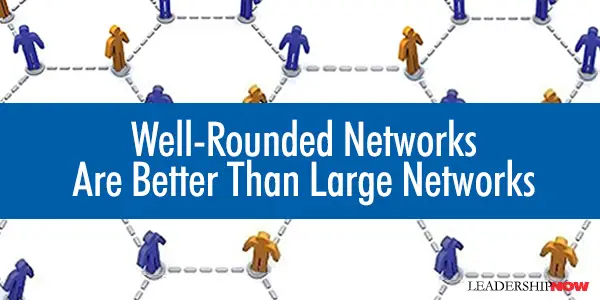 Rob Cross and Bob Thomas argue in Driving Results Through Social Networks that people who make targeted investments in relationships outperform those who simply build ever-larger networks. The former is based on quality the latter is a numbers game.
Rob Cross and Bob Thomas argue in Driving Results Through Social Networks that people who make targeted investments in relationships outperform those who simply build ever-larger networks. The former is based on quality the latter is a numbers game.
Leaders need to develop well-rounded networks. That is, networks that are not dominated by certain kinds of voices; people that are above them and below them, both inside and outside of the organization. The value here is in having the best possible and right kind of information available to you when you need it from people willing to tell you the truth. They have found that high performer's networks share three important dimensions:
They have developed an organizational network analysis to help make known the networks that exist in the informal organization. When trying to implement strategy, this becomes a crucial bit of information. If the informal networks are not aligned to the organizational objectives, the organization underperforms, and resources are not leveraged. A more nuanced view also allows for the creation of high-performing teams that do not naturally arise from the formal organization chart. This network perspective underscores the need for leadership at all levels of an organization: Whereas today we rely on two-dimensional, static, and notoriously outdated organization charts to depict what an organization is or does, soon we will be able to represent companies, even industries, the way they really are: active, in motion, growing, shrinking, flowing in the direction of opportunities, pulsating with life, and inevitably fading out of existence. This has implications for speeding productivity in newcomers: Leaders can capture greater productivity from their new hires by facilitating introductions between the newcomers and key resources as well as by ensuring that new employees quickly build a network of trusted relationships. Instead of asking only What do newcomers need to know? organizations must also ask, Whom do our newcomers need to know? 
Posted by Michael McKinney at 01:16 AM
08.18.09

How Did I Get Into This Mess?
Posted by Michael McKinney at 11:44 AM
08.13.09

Where Do You Go to Revitalize Your Standards? To account for what the eye sees, every column, instead of being a straight line from base to neck, are actually curved on a slight arc having a gentle swell in the middle or entasis. In addition, the corner columns are slightly larger in diameter than the others and are placed closer to the adjacent column than the distance between each of the other columns. This is due to the fact that the more well-lighted an object is, the smaller it will appear and thus a little further apart than the columns set against the darker background of the building wall.  As the columns rise they are angled towards the center of the temple. Remarkably, the base upon which they rest is curved upwards towards the center so as to make it look horizontally level from a distance. To offset the curvature of the base, the lower drums of the columns are made higher on one side than on the other. Without this correction the columns would lean in opposite directions. All of the deviations from the vertical and the horizontal made to enhance building's appearance required exacting mathematical calculations. The lines and angles of this geometric structure have been softened into curves so perfectly that they are imperceptible to the observer's eye and harmoniously create the builders vision. Excellence. Dan Meyer relates the story of an elderly man who returned every few years to the city of Athens for most of his adult life. Each time he would climb to the top of the Acropolis, take a seat on one of its ancient stones and spend an hour or two letting his eyes wander over the massive plateau, reflecting on the soaring columns, and the perfect proportions of the Parthenon. When asked to explain the reason for his habitual behavior, the elderly gentleman’s eyes crinkled as he smiled: “I do this because it keeps my standards high.” Where do you go for inspiration? Where do your values come from? Where do you go to revitalize your standards? 
Posted by Michael McKinney at 10:40 PM
08.12.09

Newswire: Leaders as Learners and Teachers
Posted by Michael McKinney at 10:01 AM
08.11.09

Newswire: The Evolution of Military Leadership
Posted by Michael McKinney at 04:59 PM

Ten Lessons on the Meaning of Political Greatness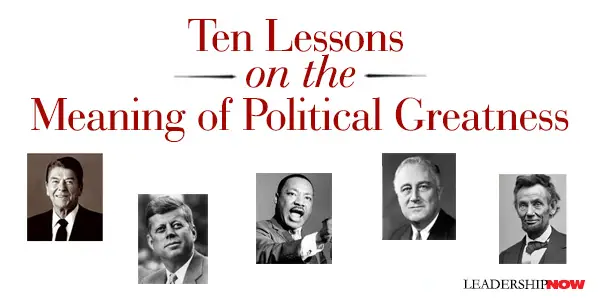
WALTER NEWELL plumbs the depths of history in The Soul of a Leader, “in order to illuminate the recent past, the present, and the challenges to come. Taken together, while they not add up to a recipe for the perfect leader, they at least show how moral, psychological, and intellectual resources we inherit from the traditions of the West, its experiences and its reflections on statecraft from ancient times onward, can give us a compass for the challenges America’s next generations of leaders will inevitably face.”

Posted by Michael McKinney at 03:25 PM
08.10.09

Taking Control of the Story: Four Helpful Questions to AskWhen emotions run high we tend to throw everything we know out the window. Staying in dialogue and in control of the stories we create about the events in our life isn’t always easy, but it is possible.It begins by taking control of and responsibility for the emotions you have created for yourself. As the authors state in Crucial Conversations, “Emotions don’t settle on you like a fog. Others don’t make you mad. You make you mad.” With that understanding you can decide to control them or be controlled by them. When you experience something, there are the facts of the situation and then there is your story about it; your conclusions, your interpretations, your judgments, and your spin on it. The most common trap is to assume that our emotions are the only valid response. Consequently, we charge ahead justified that our story is accurate and we make no attempt to change or even question it. It’s our stories that can get us into trouble and cause us to behave in ways that we know we shouldn’t. Again in Crucial Conversations they stress that we need to separate stories from facts. “When you generate stories in the blink of an eye, you can get so caught up in the moment that you begin to believe your stories are facts. They feel like facts. You confuse subjective conclusions with steel-hard data points …. ‘He’s a male chauvinist pig’ is not a fact. It’s the story Maria created to give meaning to the facts. The facts could mean just about anything.” We create stories to justify our behavior. They suggest we ask ourselves four helpful questions to get ourselves into constructive dialogue: Am I pretending not to notice my role in the problem? Why would a reasonable, rational, and decent person do this? What do I really want? What would I do right now if I really wanted these results? We must always remember that there are more stories than the one we have created. “As we tell the rest of the story, we free ourselves from the poisoning effects of unhealthy emotions. Best of all, as we regain control and move back to dialogue, we become masters of our own emotions rather than hostages.” And we free ourselves from unnecessary regret. Crucial Conversations is an indispensable guide to learning to handle your most difficult conversations and improve the quality of your life and those you lead. Make sure everyone on your team has one.
Posted by Michael McKinney at 03:19 PM
08.07.09

Learning to Apply Right View and Right Conduct to Your Decision Making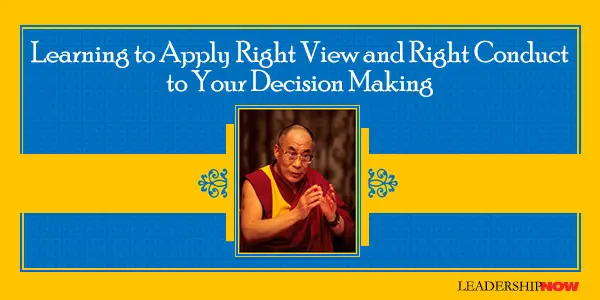
THE Dalai Lama and consultant Laurens Van Den Muyzenberg have collaborated in The Leader’s Way to fuse Buddhist and Western philosophies to address responsible leadership. In order for a leader—“one who makes the right decisions”—to make the kinds of decisions that “generate a better quality of life for themselves, their organizations, and everyone else affected by those decisions,” they must learn to “understand more clearly what happens in their minds and the minds of others.” This involves two concepts they introduce as Right View and Right Conduct. The Right View has to do with action based on the right intention and the right motivation. It means taking into account that nothing that exists is permanent, nothing exists without a cause, and every cause has many effects. The Right Conduct is the endgame; to take action that serves the needs of individuals and organizations. The right conduct should always align with your stated values and principles. When the mind is disturbed by anger, jealousy, hate, impatience, fear, lack of self-confidence, or negative emotions about things that happened in the past, it is wasting valuable time that instead should be used for constructive thinking. The purpose of training the mind is to maximize its power by focusing it on the decisions that matter. Meditation or reflective thinking plays a big part in training the mind. A Harvard study cited in the book compared brain scans of meditating and nonmeditating people and found that meditation had seemingly enlarged the part of the brain that regulates emotion, attention, and working memory. They discuss ways of developing your thinking to improve your performance, the performance of your organization, and for acting responsibly in our interdependent world. One important pattern emerged: “one should celebrate joyful events while not becoming too attached to their meaning, either in the present or as a predictor of the future.” The danger is in seeing success as permanent. Right View and Right Conduct is a process that always needs to be renewed.

Posted by Michael McKinney at 12:54 AM
08.03.09

Rules for Conquering RiskIn How the Wise Decide, authors Bryn Zeckhauser and Aaron Sandoski cite a study by Princeton psychologist Daniel Kahneman. The study finds that “our brains are programmed to worry substantially about the possibility of loss, and not enough about the size of the loss relative to the gain. We don’t like to lose period.” It’s called risk aversion. It means that we put a far greater weight on losing than on winning.The authors say the problem arises when our penchant for risk aversion begins to cloud our thinking. They write that we “can get so caught up in the possibility of losing that we ignore the realities of the situation.” We “wind up shying away from taking a risk even when the probability of winning big is high.” They ask, “What if you could routinely overcome loss aversion? Think of the possibilities if your competitors, shrinking before the prospect of possible loss, shun a move that you know has a very good possibility of succeeding. What a competitive advantage! Wise leaders are constantly searching for ways to use that advantage.” Rather than fight over the same fabric as everyone else – low risk/high reward – it’s better to investigate those situations that appear to be high risk/high reward. They give five rules for dealing with or fear of risk: Identify What Really Drives the Risk. Conventional wisdom can keep us from seeing reality. Ask what drives the risk and what information do I need to evaluate that risk. Reward People for Taking Smart Risks. Reward your team for “simply making the smart decision, not the outcome of their decisions….You have to engineer the risk-taking environment that best suits your own situation.” Test the Waters Before Taking a Plunge. “Sometimes it pays to let a concept simmer for a while, experimenting with an idea before fully committing to it. Experiments limit your downside risk, but not your upside reward.” Create a Risk-Tolerant Environment. Dean Kamen of DEKA Research & Development says that he wants “outrageous new ideas about the project that go well beyond the normal constraints of time and budget. The trouble is, if you carry the basic human aversion to risk and the need to be predictable and meet schedules into the world of R&D, you’re snuffing out the future.” Ask “What Would It Take?” The question helps you make the right decision, not the safe one. Conquering the fear of risk is just one of the six core decision-making principles presented in the book. The other five are go to the source, fill a room with barbarians, make vision your daily guide, listen with purpose, and be transparent. All are worth examining for finding application in your particular situation.
Posted by Michael McKinney at 09:38 PM
08.02.09

First Look: Leadership Books for August 2009Here's a look at some of the best leadership books to be released in August.




For bulk orders call 1-800-423-8273
Posted by Michael McKinney at 10:45 AM
|
BUILD YOUR KNOWLEDGE


How to Do Your Start-Up Right STRAIGHT TALK FOR START-UPS 
Grow Your Leadership Skills NEW AND UPCOMING LEADERSHIP BOOKS 
Leadership Minute BITE-SIZE CONCEPTS YOU CAN CHEW ON 
Classic Leadership Books BOOKS TO READ BEFORE YOU LEAD |
|